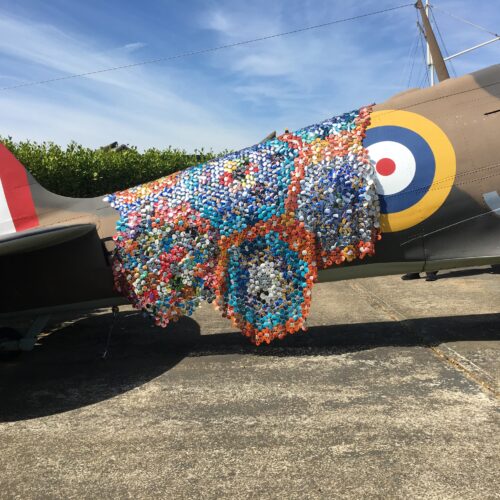
Textiles: organising your work for assessment
Thinking about assessment and sending work to the OCA head office is an anxious time for students. You have worked so hard over a long period of time, pushing yourself out of your comfort zone and taking knock backs from your tutor. So it can feel very much like crunch time when you are thinking about what the assessors will make of your work. In this blog post I hope to alleviate some of those anxieties by sharing with you what happens at assessment and how to think about your work. Following this post at the forthcoming assessment events the assessors, myself included will select examples for student work that illustrate good ways of organising your work for assessment to be posted on weareoca.com. The aim will be to give you ideas and visual information on how you can present your work for assessment.
 Firstly I will outline the assessment event itself, how your work is dealt with and who is present. When your work arrives in Barnsley it is accepted and cared for by Kathy. Kathy is a member of the office staff who is an expert with many years experience in handling student work. When it comes to the date of the event she unpacks and lays your work on a table the size of a desk you would see in a college or university. Each student has a desk each. As she unpacks the work Kathy will place things together that make sense, for example separating the assignments in to different piles. She does this according to how the work has been labelled and packed. If there are boxes these will be opened up to display the contents and fabric samples are draped carefully. What I hope you see from this is that your worked is respected and placed on the table in a way that helps the assessors navigate it. Your role is therefore to label and organise your work in a way that assists Kathy in displaying the work to the best effect. Having a thorough contents list and contact sheet of images of exactly what you are sending will help.
Firstly I will outline the assessment event itself, how your work is dealt with and who is present. When your work arrives in Barnsley it is accepted and cared for by Kathy. Kathy is a member of the office staff who is an expert with many years experience in handling student work. When it comes to the date of the event she unpacks and lays your work on a table the size of a desk you would see in a college or university. Each student has a desk each. As she unpacks the work Kathy will place things together that make sense, for example separating the assignments in to different piles. She does this according to how the work has been labelled and packed. If there are boxes these will be opened up to display the contents and fabric samples are draped carefully. What I hope you see from this is that your worked is respected and placed on the table in a way that helps the assessors navigate it. Your role is therefore to label and organise your work in a way that assists Kathy in displaying the work to the best effect. Having a thorough contents list and contact sheet of images of exactly what you are sending will help.
When it comes to assessment day your work is ready to be examined by the assessors when they arrive. The team is made up of around four OCA textile tutors including the textiles programme leader (me). These are the same folk who are assigned to you to give formative feedback during your studies. If your current tutor is one of the assessors they will not be assessing your work. This keeps things fair. Using the assessment criteria for your course the assessors work in pairs to decide on a mark. Once all the marks are in as a group the assessors go through the marks to check they are right. This rigorous approach ensures accuracy and parity.
 Assessment is daunting for students so I suggest you start thinking about the way you are going to organise your work right from the beginning of your course. Read the assessment guidelines for textiles early so you are familiar with the expectations. These can be found on the student website under resources. This planning ahead will help save time when you are under pressure and encourage a more organised approach throughout the course.
Assessment is daunting for students so I suggest you start thinking about the way you are going to organise your work right from the beginning of your course. Read the assessment guidelines for textiles early so you are familiar with the expectations. These can be found on the student website under resources. This planning ahead will help save time when you are under pressure and encourage a more organised approach throughout the course.
I would say the golden rule is be organised and keep things simple. Assessors want to be able to find things quickly and easily, and it should be a pleasure for them to investigate your work. Aim to be cohesive, that is by looking at your work it should feel like it belongs together. You can do this for example by using the same colour sketchbooks, making sure all your labels follow the same format and using only white boxes with white tissue to pack delicate samples. The way you do this is up to you, it should reflect your aesthetic sensibilities but it must never detract from the work itself.
 Things assessors don’t like seeing is work placed in individual plastic wallets or stuck into sketchbooks. This includes drawing work, two and three-dimensional textile samples, etc. Pin, stitch or bulldog clip groups of drawings or fabric samples together, putting the best ones at the top and place 3D samples in boxes. There is no need to mount work on boards, if you feel it is appropriate to mount a small amount of work this is fine but we don’t expect it. Again make sure things are labelled correctly or there is indication on the contents list as to what exactly is what.
Things assessors don’t like seeing is work placed in individual plastic wallets or stuck into sketchbooks. This includes drawing work, two and three-dimensional textile samples, etc. Pin, stitch or bulldog clip groups of drawings or fabric samples together, putting the best ones at the top and place 3D samples in boxes. There is no need to mount work on boards, if you feel it is appropriate to mount a small amount of work this is fine but we don’t expect it. Again make sure things are labelled correctly or there is indication on the contents list as to what exactly is what.
To conclude then start to think about ways of organising your work as soon as you start the course. Familiarise yourself with the guidelines for textiles and the way your work will be handled at head office. Think about how your work looks as a whole body – does it feel cohesive? Finally keep things simple and plain, ensure your work can be looked through easily and you are particular about its organisation.






This is so helpful, Rebecca, thank you! I wonder if you could say something about how assessors look at the learning log, in conjunction with the work. What if it’s an online log? Do they consider it at the same time or as a separate part of the process?
Good question Ros. Your learning log whether it is online or analogue is an integral part of your studies. It is where you demonstrate your academic thinking and the contextualisation of your work. In this respect assessors score you against the Context section of the assessment criteria. However because you demonstrate the development of ideas in both your practical work and your learning log assessors flick between both. To produce really strong creative work you also have to use your reflective and critical thinking skills and these are evidenced in you learning log. In practical terms each assessor has access to a laptop so they can sit with your work and look at online learning logs. I hope this helps.
Yes, very helpful, thanks!
Rebecca , I am still fairly new to the OCA so your advice is really helpful . It is sometimes difficult to interpret requirements and what is expected with regard to presentation . Thank you .
Really helpful to read this, Rebecca, thank you.
Confused about the statement that drawing work should not be stuck into sketchbooks. Could you clarify
thanks you
Hi Karen, thank you for your question. If you are not drawing directly into a sketchbook it is not necessary to glue the work into a book. These are much better seen as individual pieces as they will come in varying sizes and on a range of papers. In advocating that students work outside the confines of a sketchbook I hope to encourage the use of large scale drawing and the exploration of drawing on different surfaces. I hope this helps.
Hi Rebecca,
This is a late reply as I am reading up on all the advice for assessment presentation.
Regarding the advice on sketchbooks and not gluing additional sketches into the sketchbook, should we just leave them loose? apologies if this appears a daft question but I was thinking it could prove difficult for examiners when looking through our books and loose bits of paper fly out.
Hi Wendy,
Thank you for your question. Drawings on loose pieces of paper can be filed together in a large labelled envelope or similar. The package can be homemade or bought but aim for something light. I hope this helps.
Thank you Rebecca